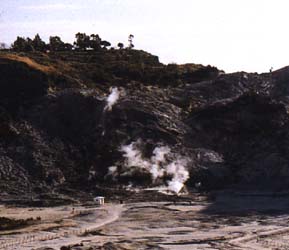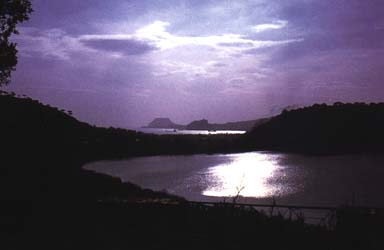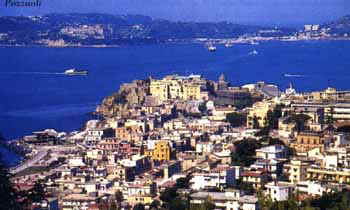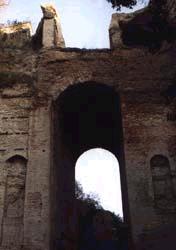Pozzuoli
|
|
Historical Notes:
It was founded in 530
B.C. by political exiles from Samos
who gave the city the auspicious name of "Dicaerarchia"
which means "just government".
Being on Cumaean territory, it was, at
first, subject to Cumae, fell in 421
B.C. under the power of Campanians
and in 338 B.C. under the Romans,
who, during the Punic wars, acknowledged
its importance as a trading and military port.
Then it changed its name in Puteoli (small
wells) and became one of the most important ports in the
Mediterranean, so that it was called "Delus minor",
and "litora mundi hospita".
The industries of glass, terracotta, perfumes, textiles, colors and
iron developed considerably, owing to the presence of local skilled
workers educated to Phoenician, Hellenistic and Egyptian traditions.
Through its port Puteoli also
assimilated other civilizations and religions. It is, in fact,
historically established that St. Paul
landed at Puteoli in A.D. 61,
found a Christian community in the city and stayed there for a week.
Puteoli thrived as long as its
port met the requirements of Roman trade, but suffered a great blow
when the Romans built the port of Ostia. Owing to
downward bradyseism, which submerged harbor facilities, and to the
fall of Rome, Puteoli became a
fishermen's center and, in the Middle Age, tourist came to the
Phlegrean area only to take thermal treatments.
After the eruption of Monte Nuovo in 1538, the social, economic
and city-plan situation of Pozzuoli
began to improve thanks to the Spanish viceroy don
Pedro de Toledo.
To visit:
Astroni: The name comes from the Latin sturnis, because of the abundance of birds, or from strioni (sorcerers). It is a beautiful and undamaged crater with a luxuriant vegetation made of ilexes, chestnut trees, oaks, elms and poplars.
 |
Solfatara:
The Solfatara volcano, whose
elliptic crater has a major axis of 770 m. and a minor one of 580
m., was formed 4000 years ago and is the only one in the
Phlegrean Fields which still exhibits an impressive fumarolic activity.
In the crater you can observe such interesting phenomena as jets of
sulphureous steam, small volcanoes spitting hot mud and bubbling jets
of sand. The last eruption of the Solfatara
is calculated to have taken place in 1198 A.D.
Neronian-Flavian
Amphitheatre: Begun under Nero
and completed by Vespasian (69-79 A.D.)
this amphitheatre is the third largest in Italy. The main axis
measures 149 meters and the transverse one 116 meters.
It could accommodate up to 20.000 spectators. The subterranean
structures are in a perfect state of preservation and nowhere else is
it possible to get so clear an idea of the complicated mechanism
required for the hosting of the caged wild beasts up to the arena.
In 305 A.D., under the emperor Diocletian,
seven Christian martyrs were condemned to be thrown to the wid beasts
in the arena of the amphitheatre: Januarius,
Festus and Desiderius
from Beneventum, Sosius from Misenum,
Proculus, Euthyches
and Acutius from Pozzuoli;
they were later beheaded near the Solfatara.
Macellum
- "Temple of Serapis":
During the excavations, which were begun in 1750, a statue of
the Egyptian god Serapis was found and therefore the edifice was
mistakenly held to be a temple. It is, however, nothing else but the
"macellum" or the city market annexed to the port
area (I-II c. A.D.).
The three columns of grey cipolin bear evident traces of the holes
made by lithodomi (marine mollusks) and show the effect of bradyseism
(slow upward and downward movement of the earth's crust).
The Macellum is enclosed in a rectangular area with a porticoes court
and row of "tabernae" (shops) down each side. In the
middle of the court rises a "tholos", a kind of
circular temple whose entablature was supported by sixteen columns, of
which three are still erect and one lies in the ground.
The magnificence of the building can be seen in the marble revetments
of the central court as well as of the two larger rooms at each end of
the apse, which were public lavatories.
Rione
Terra: This quarter,
rising steeply above the sea, was the oldest nucleus of the Greek
city, the acropolis, the citadel, the "castrum" and
the religious center. It preserves considerable traces of the street
network of the 194 B.C., when a Roman colony was established in
Pozzuoli.
On 2 March 1970, because of the phenomenon of bradyseism, the
quarter was evacuated and, after a long period of neglect and pillage,
works have just begun to make it utilizable again.
 |
Lake
Avernus: Few places in the
Phlegraean Fields evoke Homer, Virgil
and the cult of the otherworld more than lake Avernus, believed by the
ancients to be the entrance to Hades (the Underworld).
It is a lake of volcanic origin, its depth at the center reaches about
34 meters.
in 37 B.C. Agrippa linked it by a
canal first with lake Lucrino and later
with the sea, and transformed lake Avernus into
a impressive dockyard (Portus Julius).
Lake
Avernus "Temple of Apollo":
On the eastern shore of Lake Avernus you
can admire the imposant thermal hall, known as the "Temple
of Apollo", which dates from the reign of Hadrian
(2nd century A.D.).
It had originally a domed roof and its diameter (about 38 m.)
is a little less than that of the Pantheon in Rome.
Temple of Augustus : Brought to light after the burning of the cathedral in 1964, which revealed beautiful corinthian columns, the so-called Temple of Augustus was the city's "Capitolium" during the republican age. By will of Lucius Calpurnius, a rich Puteolan merchant, it was rebuilt by the architect Lucius Cocceius Auctus during the age of Augustus: it was converted into a Christian church between the 5th and the 6th century A.D. and then into a cathedral. It was remodeled in the Baroque style during the episcopate of Martino de Leon y Cardenas (1631-1650). It's now under restoration.
Temple of Neptune : The constructions of this monument dates back the reign of Hadrian (2nd century A.D.). It is a grandiose archeological complex and may be included amongst the most imposing thermal establishments of ancient Puteoli.
Monte Nuovo : It's the youngest mountain in Europe and was formed after a volcanic eruption on 29 September 1538. This eruption, preceded by numerous earthquakes, swallowed up the village of Tripergole on the east shore of Lake Lucrino and caused the depopulation of Pozzuoli.
Submerged remains of Portus Julius : In 37 B.C., during the civil war between Octavian and Sextus Pompeius, M. Vipsanius Agrippa, Octavian's strategist, ordered the construction of a navigable canal
|
|
connecting Lake Avernus, Lake Lucrino and the sea and created a grandiose naval base (Portus Julius), which was used as a dockyard for the fleet of Misenum. Owing to the descending phase of bradyseism Portus Julius is mostly submerged; when the sea is calm, however, imposant remains of port structures and of some suburban "vici" can still be seen between Pozzuoli and Baia.
Arco Felice : This grandiose construction, 20 m. high and 6 m. wide, is a deep cutting through Mount Grillo made by the Romans in order to provide an easier transit from Cumae to Pozzuoli on the Domitian Road (A.D. 95).

